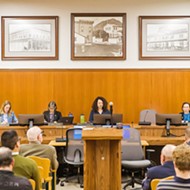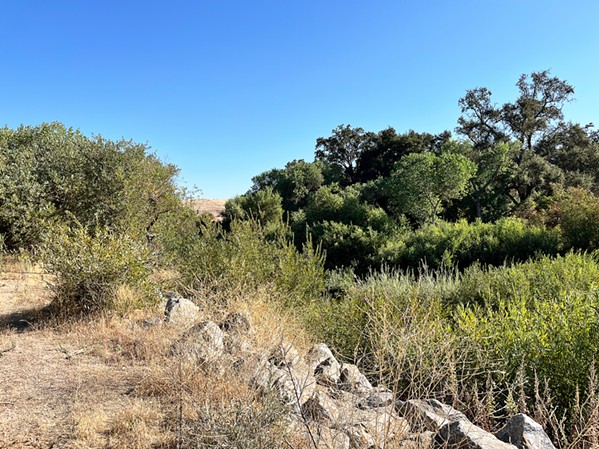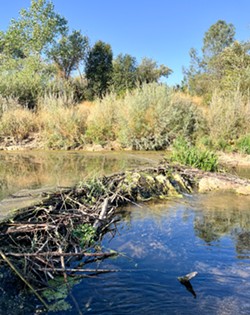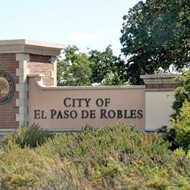Dam it up: North County cities are using man-made and natural beaver dams to control erosion and fire in the Salinas Riverbed
By Libbey Hanson[
{
"name": "Newsletter Promo",
"id": "NewsletterPromo",
"class": "inlineCenter",
"insertPoint": "4",
"component": "15264767",
"requiredCountToDisplay": "0"
},
{
"name": "Ad - Medium Rectangle CC01 - 300x250 - Inline Content",
"class": "inlineCenter",
"insertPoint": "8",
"component": "15582119",
"requiredCountToDisplay": "12"
},{
"name": "Ad - Medium Rectangle LC01 - 300x250 - Inline Content",
"class": "inlineCenter",
"insertPoint": "18",
"component": "15582122",
"requiredCountToDisplay": "22"
},{
"name": "Ad - Medium Rectangle 9 - 300x250 - Inline Content",
"class": "inlineCenter",
"insertPoint": "28",
"component": "15582121",
"requiredCountToDisplay": "32"
}]
There's a clear distinction between the dry land and lush riverbed along the Upper Salinas River in Atascadero.
Tracks along the shoreline in late August reveal that a branch was recently dragged into the stream. A pile of fresh wood shavings and deep divots on the riverbed floor lead up to an architectured dam—the beavers were busy the previous night.
According to SLO Beaver Brigade Founder Audrey Taub, the family of beavers that reside in this area is one of four in Atascadero. They maintain two dams that span the width of the riverbed holding up to 3 feet of water that slowly flows for about a mile, to which Taub named them "ecosystem engineers."
Even in times of drought, these beaver-inhabited areas remain wet year-round and provide a resource that humans have historically tried to engineer for fire prevention, water retention, and species conservation, said Taub, whose group monitors the activity in the area.
Both Atascadero and Paso Robles are using beaver engineering to help reintroduce the amphibious rodents to the area and allow the animals to maintain a lush Salinas Riverbed by doing what they do best—being beavers.
On Aug. 26 Paso Robles notified residents of a riverbed project to harvest willow stakes to enhance environmental health and water quality in the Upper Salinas River corridor starting in October. Its purpose: to build man-made beaver dams in Atascadero.
Willow stake harvesting involves trimming live willows and replanting those pieces along unstable riverbeds. The willow stakes eventually form a new root structure and provide soil stability, preventing further erosion along the bed.
Upper Salinas-Las Tablas Resource Conservation District (RCD) Executive Director Devin Best helped spearhead this project and is currently working on engineering beaver dam analogs—human-made dams that mimic beaver activity.
"[Analogs] just seems kind of the path of least resistance on some level, and also has real potential to kind of change the way that we're addressing species decline, climate change, landowner resiliency, and all these other concerns that we're trying to deal with on a large scale," Best said. "But a much more strategic and effective method."
With funding from the county, and a partnership with the California Conservation Corps, the organizations will collect willow stakes within the Salinas River in Paso and transport them to the Atascadero area to assist with erosion issues.
The project started when SLO County contacted the RCD about a quick fix for some erosion near a pipeline on private land near the Upper Salinas Riverbed. When Best assessed the land, he determined that process-based restoration was the solution, a low-technology strategy that mimics nature and eventually could involve beavers.
"One of the elements of process-based restoration is using beaver dam analogs because they replicate natural stream channel morphology and processes to help reduce sediment and increase water retention, and actually do some flooding, which is a good thing that you want to see when they hold water during certain events of the year," Best said.
He said they hope to encourage vegetation growth where none currently exists.
"By incorporating some willows in there and keeping them alive, we hope to restore the riparian corridor as well as maybe find some beavers that might move back into that area," he said.
Beaver dam analogs use the same natural resources that beavers use, such as tree branches, clay, and dirt. The process involves weaving tree branches and dirt either alongside the shore of the river for erosion control or perpendicular to the stream for damming.
Paso Robles Public Works Operations Manager David LaCaro worked with the RCD to provide the willow stakes, and said the city of Paso is trying to make its own beaver dam analogs along the Salinas River, creating protection from fires and investing in a green riverside.
Within the past years, Paso has experienced fires due to its current dry riverbed and ever-growing weeds and has started to use goats as natural weed abaters. LaCaro wants to take it one step further and prevent fires with flowing water, water that would come from the man-made dams.
If water can pool in the riverbed behind a man-made beaver dam, LaCaro said that water will seep into the ground and encourage green growth even in a drought. This moisture can prevent or stop major fires—an issue LaCaro said Paso is currently trying to address.
Not only does a green riverbed mean fewer fires, but LaCaro sees green as a benefit to the city.
"One of the things that we've been encouraging here in the city of Paso is just using [the] Salinas River as an asset," he said. "It's so beautiful. But if you look at the way the town is divided, a lot of the businesses face toward the downtown area. We have such a beautiful waterway that goes right through it. So if we can bring back some of that greenery, bring back some habitat, we can turn that into an asset itself."
RCD Executive Director Best said beaver dam analogs are a "win-win-win." They provide a green riverbed and more simple engineering solutions, as well as encourage more beavers to live in the area and continue those damming efforts.
After beavers faced near-extinction, Best said this engineering is a great way to give back to the species humans have learned so much from.
"Ever since they disappeared, we've been seeing eroding and overgrown riparians, and it's not being maintained. [Beavers] were nature's engineers, and they were doing a great job. Then we interrupted their whole sort of ecology," he said. "So anything we can do to kind of put them back to some level and replicate that, I think we'd be moving in the right direction."
Best said the implementation of the beaver dam analogs may involve some trial and error, but that's the nature of process-based restorations.
"The concern is, are these things going to work and are they going to be successful? And it's like, well, you have to start to find out what works and what doesn't work," he said. "So I'm happy to be sort of that risk taker and at the forefront of ... the early adoption of these things here locally."
Willow stake harvesting in Paso Robles is scheduled to begin at the end of September, and construction of the Atascadero dams between Oct. 1 and 15. Δ
Reach Staff Writer Libbey Hanson at [email protected].
Latest in News
Readers also liked…
-

When the levee breaks: Oceano residents, county officials walk a tightrope of regulations to manage Arroyo Grande Creek, which some say led to the levee's failure in January
May 18, 2023 -

Cal Poly report highlights offshore wind's potential to spur green energy transition
Jun 8, 2023 -

Cal Poly students demand rent control, accountability for substandard housing from SLO City Council
Jun 22, 2023










